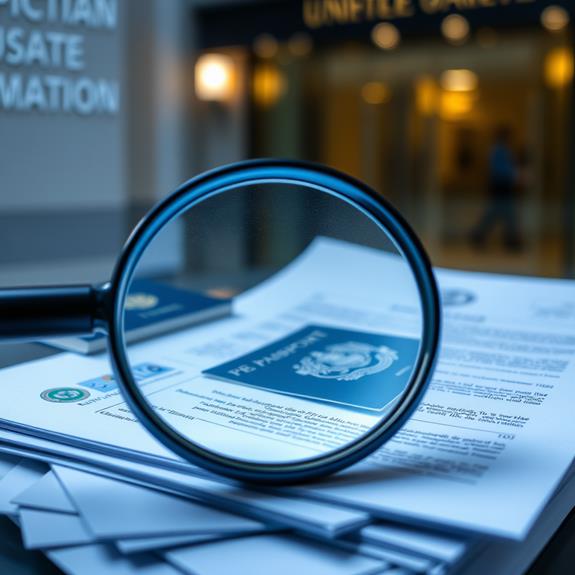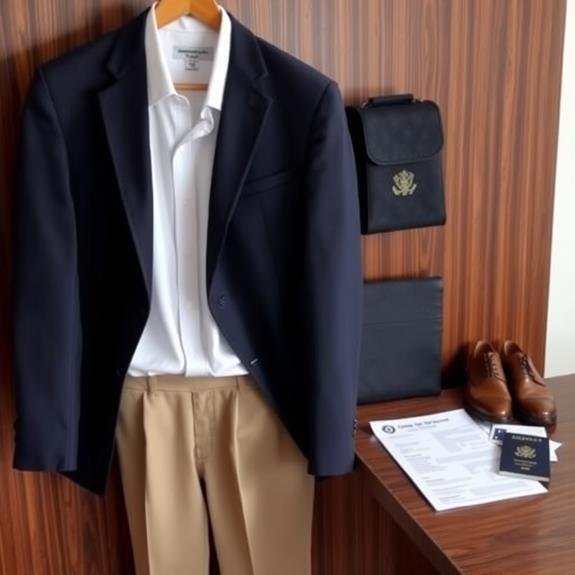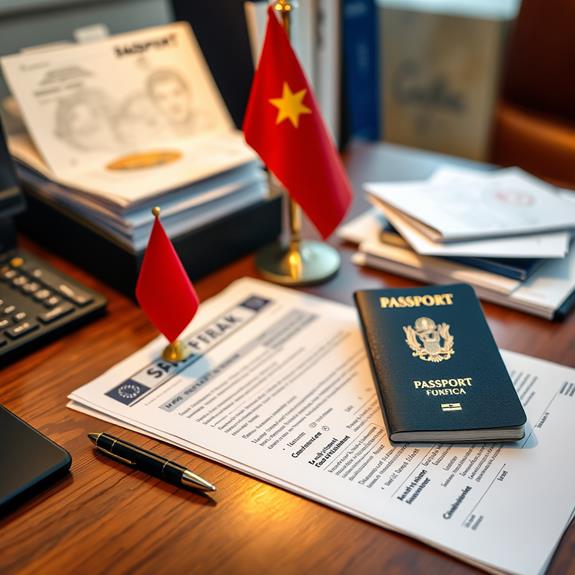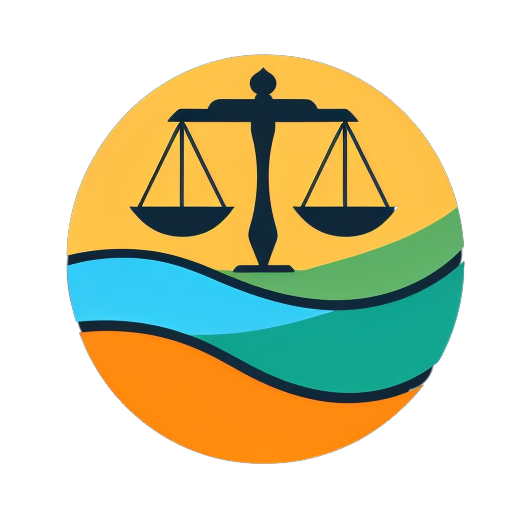To ace your visa interview, start by thoroughly understanding your visa category and gathering all required documents. Review your application details carefully and practice answering common interview questions. Dress professionally to make a good impression, and arrive early to calm your nerves. During the interview, communicate clearly and confidently, maintaining eye contact and providing concise answers. After the interview, follow up on the outcome and be prepared to submit any additional requested information. Remember, preparation is key to success. The following steps will guide you through the process in more detail.
Understand Your Visa Category

Before diving into your visa interview preparation, it's vital to thoroughly understand the specific visa category you're applying for. Each visa type has unique requirements, purposes, and visa eligibility criteria. Take time to research your chosen category, whether it's for work, study, tourism, or family reunion. Familiarize yourself with the visa application process and gather all necessary documents. For B-1/B-2 visas, expert consultants can provide invaluable guidance through each step of the process, enhancing your chances of approval. Understanding the specific requirements for business or tourist visas is important for a successful application.
Review the official government websites for detailed information about your visa category. Pay close attention to the purpose of your visit, allowed duration of stay, and any restrictions associated with your visa type. Understanding these details will help you answer interview questions accurately and confidently. Make sure you meet all the basic requirements for your visa category before proceeding with your application.
Prepare a clear explanation of why you've chosen this specific visa category and how it aligns with your intentions. Be ready to discuss your plans during your stay and how they fit within the visa's guidelines. This knowledge will demonstrate to the visa officer that you've done your homework and are serious about complying with visa regulations.
Gather Required Documents
The foundation of a successful visa interview lies in having all your required documents in order. Start by creating a detailed document checklist to guarantee you don't miss any essential paperwork. This list will vary depending on your visa category, but there are some common items you'll need to gather. For B-1/B-2 visas, consider including a detailed itinerary for business trips or proof of tourism plans. A thorough eligibility assessment can help identify any potential challenges in your application process.
- Valid passport with at least six months validity beyond your intended stay
- Completed visa application form
- Recent passport-sized photographs
- Proof of financial means to support your stay
- Travel itinerary or round-trip ticket
Once you've compiled your checklist, carefully review each document to confirm it's up-to-date and accurately filled out. Make copies of everything, as you may need to submit both originals and duplicates. Organize your paperwork in a logical order, making it easy to access during the interview. This preparation will demonstrate your meticulousness and attention to detail to the visa officer.
Review Application Details Thoroughly

A magnifying glass approach to your visa application can make all the difference. Before your interview, take the time to review every detail of your application thoroughly. This step is essential for ensuring application accuracy and understanding the significance of each piece of information you've provided. For H-1B visa applicants, this includes verifying that your job position aligns with specialty occupation requirements and that your educational background meets the minimum criteria.
Start by carefully reading through your entire application form. Check that all names, dates, and addresses are correct and match your supporting documents. Pay close attention to your travel dates and the purpose of your trip. These details are often the focus of interview questions. Make sure you can explain any complex or unusual aspects of your application.
Next, review your supporting documents. Confirm that you've included all required paperwork and that each document is current and legible. Understanding the detail significance of each item will help you answer questions confidently during the interview.
Practice Common Interview Questions
You'll want to prepare for common visa interview questions in advance. Take time to anticipate what the interviewer might ask, considering your specific visa type and personal circumstances. Practice your responses out loud, focusing on clear, concise answers that demonstrate your eligibility and intentions.
Anticipate Likely Queries
While preparing for your visa interview, practicing common questions is essential for boosting your confidence and performance. However, it's equally important to anticipate likely queries specific to your situation. Consider the purpose of your visa application and think about questions that might arise. Here are some areas to focus on:
- Your reasons for travel or immigration
- Your ties to your home country
- Your financial situation and ability to support yourself
- Your plans for returning home after your visa expires
Remember that visa officers are trained to spot inconsistencies, so be prepared to discuss your personal experiences and cultural differences. They may ask about your educational background, work history, or family situation. It's vital to have clear, honest answers ready for these topics. Don't memorize responses word-for-word, but rather understand the key points you want to convey. This approach will help you appear more natural and confident during the interview. By anticipating likely queries, you'll be better equipped to handle unexpected questions and demonstrate your genuine intentions for obtaining the visa.
Rehearse Confident Responses
Through consistent practice, you can develop confident responses to common visa interview questions. Start by creating a list of potential questions based on your visa type and purpose of travel. Then, craft clear, concise answers that highlight your qualifications and intentions. Remember to keep your responses honest and aligned with the information in your application.
To improve your delivery, conduct mock interviews with friends or family members. This will help you become comfortable with the interview format and refine your answers. Pay attention to your body language during these practice sessions. Maintain good posture, make appropriate eye contact, and use natural hand gestures to convey confidence and openness.
As you rehearse, focus on speaking clearly and at a moderate pace. Avoid rushing through your responses or using filler words like "um" or "uh." If you need a moment to gather your thoughts, it's okay to pause briefly before answering. Practice until your responses feel natural and you can deliver them with ease. This preparation will help you feel more relaxed and confident during the actual interview, increasing your chances of success.
Dress Appropriately for Success

Dressing for success in your visa interview goes beyond simply looking good. Your attire communicates professionalism and respect for the process. Consider color psychology when selecting your outfit; neutral colors like navy, gray, or black convey seriousness and reliability. Fabric choices matter too; opt for wrinkle-resistant materials that look crisp and neat.
Choose clothing that's comfortable yet formal. You'll want to feel at ease during the interview, but avoid anything too casual. Stick to classic, conservative styles that won't distract from your qualifications. Remember, your goal is to present yourself as a responsible, trustworthy applicant.
Here are key points to keep in mind when dressing for your visa interview:
- Wear clean, well-fitting clothes that are appropriate for a business setting
- Choose closed-toe shoes in good condition
- Keep jewelry and accessories minimal and subtle
- Make certain your grooming is neat and tidy
Arrive Early and Composed
To guarantee you're relaxed and prepared for your visa interview, it's essential to plan your journey well in advance. You'll want to arrive at least 30 minutes early, dressed in professional attire that makes you feel confident and comfortable. Before entering the building, take a few deep breaths to calm your nerves and focus your mind on the task ahead.
Plan Your Journey
The journey to your visa interview begins long before you step into the consulate. Proper planning can make a significant difference in your experience and outcome. Start by focusing on travel logistics and journey mapping to guarantee a smooth process. Consider the following key points:
- Research the consulate's location and surrounding area
- Check traffic patterns and potential delays
- Plan multiple routes to avoid unexpected setbacks
- Prepare a packing list for necessary documents and items
When planning your journey, factor in extra time for security checks and potential queues. It's wise to arrive at least 30 minutes before your scheduled appointment. This buffer allows you to compose yourself and review your documents one last time. If you're using public transportation, familiarize yourself with the schedules and stops. For those driving, locate parking options in advance. Remember to account for weather conditions that might affect your travel time. By thoroughly planning your journey, you'll reduce stress and increase your chances of arriving early and composed. This preparation sets a positive tone for your interview and demonstrates your reliability and organizational skills to the visa officer.
Dress Professionally
Your appearance speaks volumes before you utter a single word. When preparing for your visa interview, dressing professionally is essential. Opt for business attire that's neat, clean, and well-fitted. For men, this typically means a suit or dress pants with a collared shirt and tie. Women can choose a suit, dress, or a blouse with a skirt or pants. Avoid flashy jewelry or excessive accessories that might distract.
Color choices matter too. Stick to neutral, conservative colors like navy, gray, or black. These convey professionalism and seriousness. Avoid bright or loud patterns that may seem inappropriate for the occasion. Make certain your shoes are polished and match your outfit.
Personal grooming is equally important. Confirm your hair is neat and styled conservatively. For men, be clean-shaven or have a well-groomed beard. Women should opt for minimal makeup and a professional hairstyle. Don't forget about personal hygiene – use deodorant and avoid strong perfumes or colognes.
Calm Nerves Beforehand
Four key strategies can help you calm your nerves before your visa interview. Arriving early and composed is essential for making a positive impression. Plan to reach the interview location at least 30 minutes before your scheduled time. This buffer allows you to navigate unexpected delays and gives you time to collect your thoughts.
Once you've arrived, find a quiet spot to practice some calming techniques:
- Take deep, slow breaths to lower your heart rate
- Use positive visualization to imagine a successful interview
- Review your documents one last time for confidence
- Listen to soothing music or a motivational podcast
Communicate Clearly and Confidently

During your visa interview, clear and confident communication is essential for success. Speak slowly and enunciate your words to guarantee the interviewer understands you. Maintain eye contact and use appropriate body language to convey confidence. Sit up straight, smile when appropriate, and avoid fidgeting or crossing your arms.
Practice active listening by paying close attention to the interviewer's questions. If you don't understand something, politely ask for clarification. Respond directly to the questions asked, providing concise and relevant answers. Be honest and consistent in your responses, as inconsistencies may raise suspicions.
Use a respectful tone throughout the interview, addressing the interviewer formally unless instructed otherwise. Avoid interrupting or arguing, even if you disagree with a statement. Instead, calmly explain your position if necessary.
Prepare examples to support your answers, but don't ramble or provide unnecessary details. Stick to the facts and be prepared to elaborate if asked. Remember to breathe naturally and pause briefly before answering complex questions. This will help you gather your thoughts and respond more effectively.
Follow-up on Interview Outcomes
After completing your visa interview, it is crucial to understand the next steps and potential outcomes. The consular officer will inform you of the interview outcomes, which typically fall into three categories: approved, denied, or pending further review. If approved, you'll receive instructions on passport collection and visa issuance. For denials, you'll get a written explanation and possible options for reapplication. Pending cases may require additional documentation or administrative processing.
To effectively follow up on your interview outcomes, consider these strategies:
- Keep all documents and reference numbers provided during the interview
- Check the embassy or consulate's website regularly for updates
- Contact the visa office through approved channels if you haven't received a response within the stated timeframe
- Prepare any additional requested documents promptly

